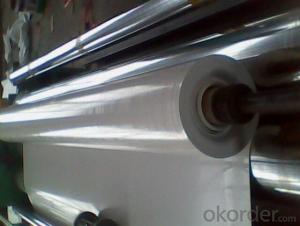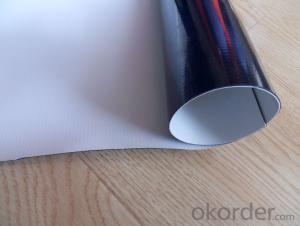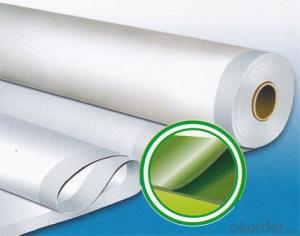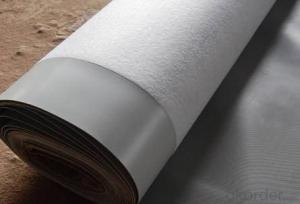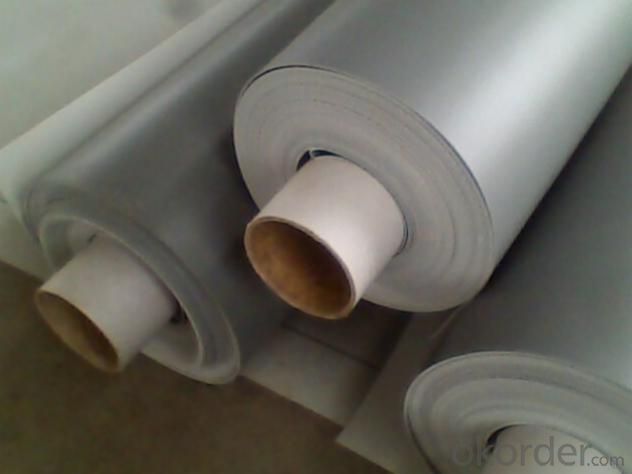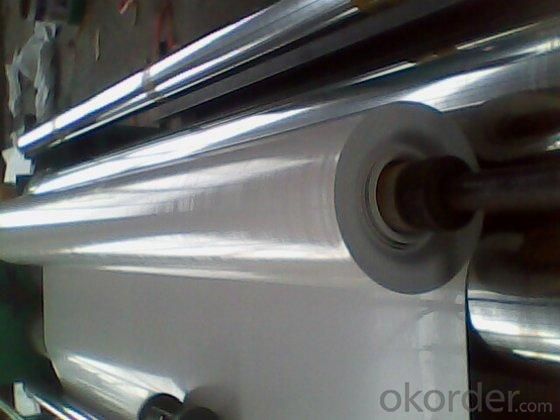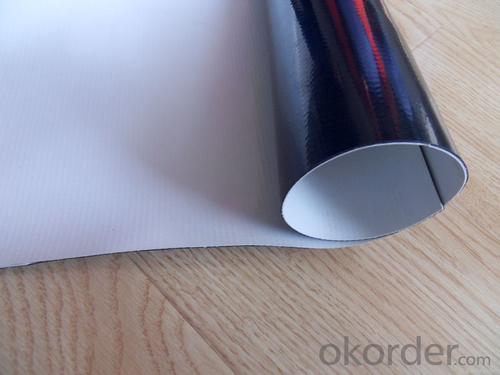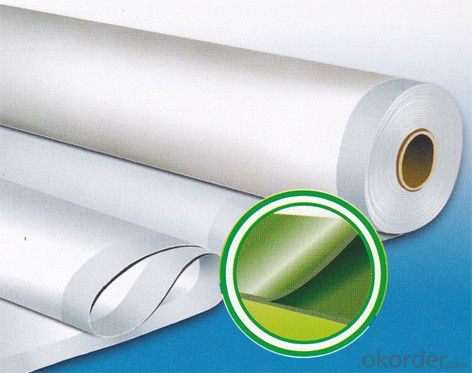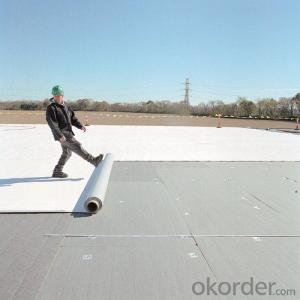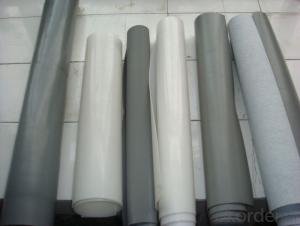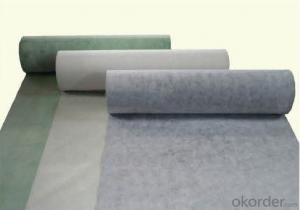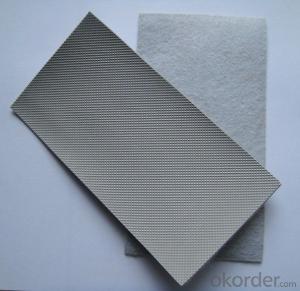PVC Waterproofing Membrane with UV-Resistance
- Loading Port:
- Shanghai
- Payment Terms:
- TT OR LC
- Min Order Qty:
- 20000 m²
- Supply Capability:
- 5000000 m²/month
OKorder Service Pledge
OKorder Financial Service
You Might Also Like
PVC Waterproofing Membrane with UV-Resistance
Product Description of PVC Waterproofing Membrane with UV-Resistance:
PVC waterproofing membrane is an excellent high-quality polymer waterproof sheet, made of PVC resin by adding plasticizer, anti-UV agent, anti aging agent, and stabilizer and other processing aids through extrusion and molding. As the highly recommended product by the Ministry of Construction, it is featured by high tensile strength, great elongation, good stability, small shrinkage, low-temperature performances, good resistance to weathering and root
penetration, and long service life.
Features of PVC Waterproofing Membrane with UV-Resistance:
1.Long service life and weathering resistance; and the materials can be used for 30 years on the roof and 50 years underground.
2. High tensile strength, great elongation, and small size change during heat treatment.
3. Good low temperature flexibility and adaptability to environmental temperature changes.
4. Good resistance to root penetration. It can be made for green roofs.
5. Excellent resistance to puncture and impact.
6. Convenient for construction (can be welded), solid and reliable, and Eco-friendly.
7. Strong resistance to chemical corrosion, suitable for special occasions.
8. Good plasticity, convenient and quick corner detail treatment. Easy maintenance and low cost.
9.After 2,000 hours of manual weathering verification
Classification of PVC Waterproofing Membrane with UV-Resistance:
1. N: Homogeneous PVC membrane
2. L: PVC membrane with fabric backing
3. W: Reinforced PVC membrane
Advantage of PVC Waterproofing Membrane with UV-Resistance:
1.) Mixing automation. Apply automatic temperature control automatic time control and automatic feed control.
2.) Extrusion equipment uses twin screw coextrusion. Screw temperature uses computer automatic temperature control system.
3.) Handpiece uses large width didhead extrusion equipment.
4.) Sophisticated three-roller calender equipment. The space between equiment is controlled by automation system.
Technical Data of PVC Waterproofing Membrane with UV-Resistance:
No. | Item | Model Ⅱ | |
1 | Tensile Strength Mpa ≥ | 12.0 | |
2 | Elongation at break% ≥ | 250 | |
3 | Shrinkage rate % ≤ | 2.0 | |
4 | Flexibility at low temperature | No crackle at -25oC | |
5 | Water tightness | Watertight | |
6 | Puncture resistance | Watertight | |
7 | Heat aging treatment | Appearance | Free from bubble, crack, cohesion and void |
Change rate of tensile strength % | +20oC | ||
Change rate of elongation at break | |||
Flexibility at low temperature | No crack at -20oC | ||
8 | Chemical corrosion resistance | Change rate of tensile strength % | +20 |
Change rate of elongation at break | |||
Flexibility at low temperature | No crack at -20oC | ||
9 | Artificial weathering | Change rate of tensile strength % | +20 |
Change rate of elongation at break | |||
Flexibility at low temperature | No crack at -20oC | ||
Application of PVC Waterproofing Membrane with UV-Resistance:
1) All kinds of roofs, such as steel structure roof, planted roof etc.
2) Underground engineering, such as building basement, subways, tunnels, air raid shelter, etc.
3) Other projects like artificial lake, dam, water reservoir, grain storehouse, etc.
Images of PVC Waterproofing Membrane with UV-Resistance:
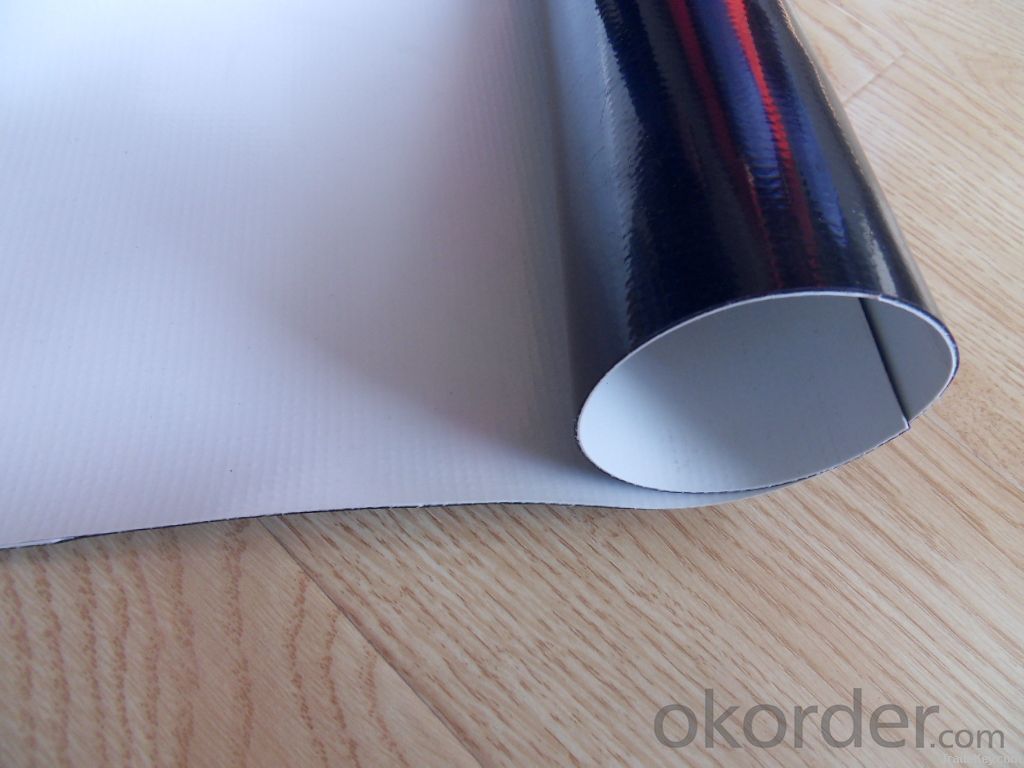
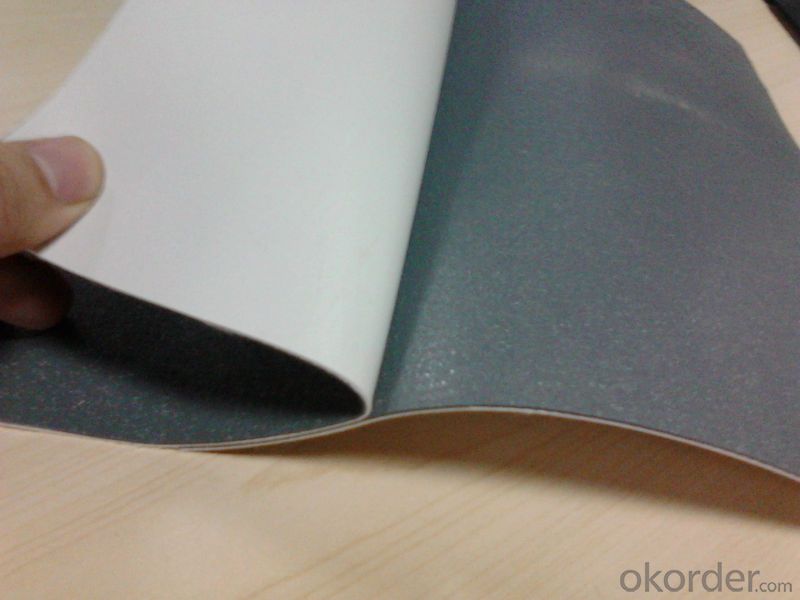
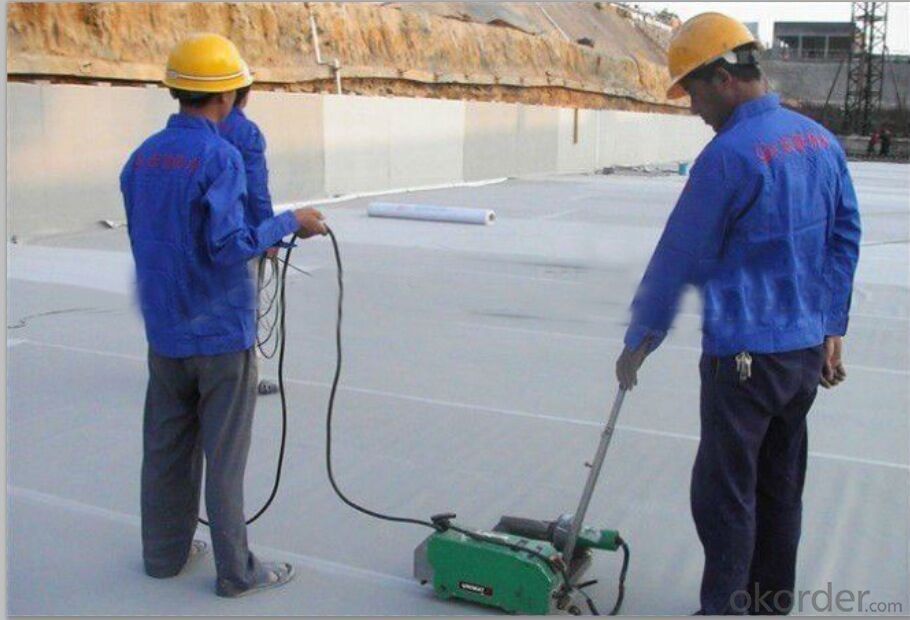

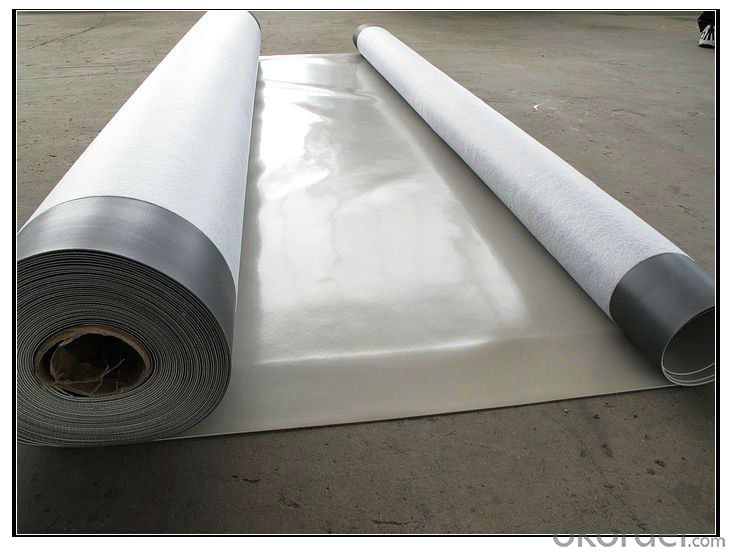
FAQ of PVC Waterproofing Membrane with UV-Resistance:
1. Can you produce 4m width?
Yes, no problem for us. We have four bases in China, largest one in this field.
2. How many quantity in one 20'' container for 1.2mm and 1.5mm?
480rolls, 11520m2 for 1.2mm and 400rolls, 9600m2 for 1.5mm
3. Can you provide free samples?
Yes, our samples are free, but express fees usually on buyer's account.
- Q: Can a waterproofing membrane be used for a balcony deck coating?
- Yes, a waterproofing membrane can be used for a balcony deck coating. Waterproofing membranes are often used to protect and seal balconies and decks from water damage, providing a durable and long-lasting solution.
- Q: Is a waterproofing membrane compatible with different types of roofing materials?
- Yes, a waterproofing membrane is compatible with different types of roofing materials. It can be used with various roofing systems such as asphalt shingles, metal, concrete, or tile roofs. The purpose of a waterproofing membrane is to create a barrier against moisture, regardless of the roofing material used.
- Q: Can a waterproofing membrane be used for tunnels or subway systems?
- Tunnels and subway systems frequently encounter water infiltration as a result of the soil conditions or groundwater levels in their vicinity. To counteract this issue, a waterproofing membrane is commonly employed. This membrane serves as a protective shield, effectively obstructing water from permeating into the tunnels or subway systems. Its installation is typically carried out on the outer surfaces of the tunnel walls and roof, establishing an impervious seal. By doing so, it aids in the prevention of corrosion, decay, and harm to the structural components of the tunnels, guaranteeing the durability and safety of these subterranean infrastructures.
- Q: How does a waterproofing membrane handle movement in structural elements?
- A waterproofing membrane is designed to handle movement in structural elements through its flexibility and elasticity. It is typically made from materials that can stretch and contract to accommodate the natural movement of the building, such as expansion and contraction due to temperature variations or settling of the foundation. When structural elements, such as walls or floors, move or shift, the waterproofing membrane remains intact and allows the movement without compromising its waterproofing properties. It acts as a protective barrier, preventing water penetration into the building, which could lead to leaks, moisture damage, or even structural deterioration. To handle movement, waterproofing membranes are often installed with certain techniques that allow for flexibility. For instance, they may be applied in multiple layers or with overlaps to provide extra protection against potential cracks or gaps that may occur due to movement. Additionally, some membranes have the ability to self-heal or reseal themselves, ensuring continuous waterproofing even if small cracks or punctures develop. Overall, a waterproofing membrane is designed to be durable and resilient, able to withstand the movement of structural elements without compromising its effectiveness. It is an essential component in protecting buildings from water damage and maintaining their structural integrity.
- Q: Can a waterproofing membrane be used on tunnels with emergency exits?
- Yes, a waterproofing membrane can be used on tunnels with emergency exits. In fact, it is highly recommended to use waterproofing membranes in tunnels to protect them from water infiltration and potential damage. These membranes create a barrier against moisture, preventing leaks and ensuring the structural integrity of the tunnel. Emergency exits can also be effectively waterproofed using appropriate membranes to maintain their functionality in case of emergencies.
- Q: Can a waterproofing membrane be used for both interior and exterior applications?
- Indeed, a waterproofing membrane holds the capability to be utilized for both interior and exterior purposes. The primary purpose of waterproofing membranes revolves around averting the intrusion of water and safeguarding against moisture-induced harm. These membranes are extensively employed in basements, bathrooms, and various indoor areas to obstruct the infiltration of water and the subsequent development of dampness. Moreover, the application of waterproofing membranes on the external surface of edifices offers defense against rain, snow, and other extrinsic factors. By employing a waterproofing membrane for both interior and exterior applications, one can ensure a comprehensive safeguard against water-related destruction, ultimately preserving the structural integrity of their property.
- Q: Does a waterproofing membrane need to be primed before installation?
- Yes, a waterproofing membrane typically requires priming before installation. Priming helps improve the adhesion of the membrane to the substrate and ensures proper bonding, enhancing the overall effectiveness and durability of the waterproofing system.
- Q: Is a waterproofing membrane resistant to UV rays?
- Yes, a waterproofing membrane can be resistant to UV rays. Many waterproofing membranes are designed and manufactured with additives that provide protection against UV rays. These additives help to prevent the membrane from degrading and losing its waterproofing properties when exposed to sunlight. UV resistance is an important feature in waterproofing membranes, especially for applications where the membrane will be exposed to direct sunlight for extended periods of time, such as on rooftops or outdoor structures. However, it is important to note that the level of UV resistance can vary depending on the specific type and brand of waterproofing membrane. Therefore, it is always recommended to check the product specifications and consult with the manufacturer to ensure that the chosen membrane offers the desired level of UV resistance for the intended application.
- Q: Can waterproofing membranes be installed on uneven surfaces?
- Waterproofing membranes possess the capability to be installed on surfaces that are not even. In reality, one of the benefits of these membranes is their ability to adapt to different irregularities and unevenness on the surface. Typically, these membranes are flexible and can be easily shaped and adjusted to fit the contours of the substrate. Furthermore, certain waterproofing membranes possess self-adhesive properties or can be applied with adhesives, enabling them to effectively stick to both smooth and uneven surfaces. Nevertheless, it is crucial to emphasize that proper surface preparation is essential for a successful installation. The surface must be clean, dry, and devoid of any loose materials or debris to ensure the optimum adhesion and performance of the waterproofing membrane.
- Q: Are there any specific considerations for installing a waterproofing membrane on concrete surfaces?
- Installing a waterproofing membrane on concrete surfaces requires careful attention to several specific considerations. Firstly, it is crucial to thoroughly clean the concrete surface and remove any loose materials, oil, grease, or contaminants that could hinder the adhesion of the membrane. Failure to do so may compromise the effectiveness of the waterproofing. Secondly, it is of utmost importance to inspect the concrete surface for cracks, spalling, or other types of damage. Prior to installing the waterproofing membrane, these defects must be repaired to prevent water from penetrating through the membrane and compromising its ability to protect the concrete. Moreover, the selection of the appropriate type of waterproofing membrane is essential. There are various options available, such as sheet membranes, liquid-applied membranes, and cementitious coatings. Each type has different application methods, durability, flexibility, and resistance to substances. Therefore, it is crucial to choose the membrane that best suits the specific concrete surface and its intended use. In addition, the installation process should strictly adhere to the manufacturer's instructions. This includes applying the membrane at the recommended thickness, ensuring proper overlap and adhesion of the seams, and using any recommended primers or adhesives. Lastly, long-term maintenance and durability should be taken into consideration. Regular inspections, maintenance, and repairs are necessary to ensure the membrane remains intact and effective in preventing water penetration.
Send your message to us
PVC Waterproofing Membrane with UV-Resistance
- Loading Port:
- Shanghai
- Payment Terms:
- TT OR LC
- Min Order Qty:
- 20000 m²
- Supply Capability:
- 5000000 m²/month
OKorder Service Pledge
OKorder Financial Service
Similar products
Hot products
Hot Searches
Related keywords

